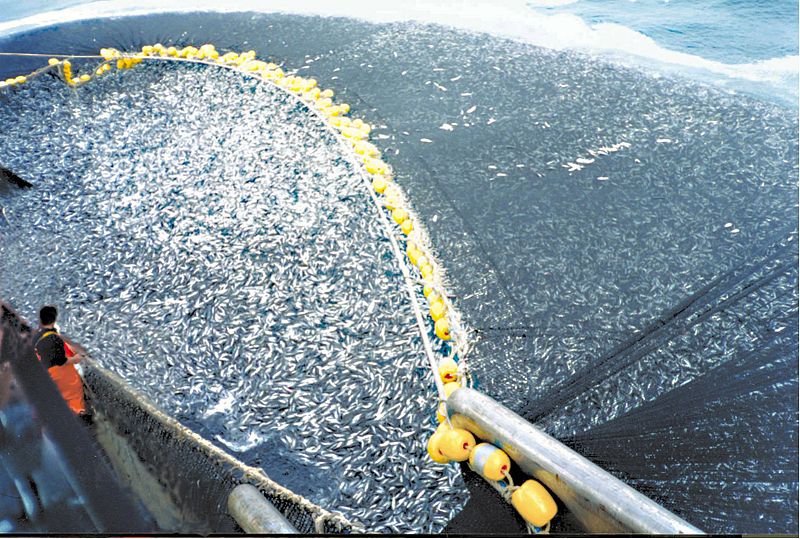
A purse seine attached to a trawler
Global fishing production accounted for nearly 90 billion tons of biomass harvested harvested from all sources of fishing in 2007. Yet, as the fishing industry grows thanks to innovations such as the purse seine, which increase fishing production, pressure to remain profitable and retain profit margins drive fishermen to overfish or poach others' fishing grounds, reducing the populations' ability to reproduce and retain sustainable levels of biomass.
To illustrate a what's at risk, a recent McKinsey study on fishery management around the world included a case study on the Eastern Atlantic bluefin tuna. Although it only accounts for 13,500 tons of biomass of the 90 billion tons caught, it generates more than $300 million in revenue due to the high value placed on it by specialized consumer segments (namely, the Japanese sushi market). If current conditions continue, the supply of the fish will collapse before 2015 due to near-extinction status. While it will remain profitable in the short run (McKinsey estimates net incomes of around $100 million per year up until 2014), the estimated future losses in terms of present value of the fish becoming unharvestable reach $2.6 billion dollars (from the time the stock is completely endangered to the time that the biomass reaches sufficient sustainablility levels). That means thousands of restaurants, fishermen, and ports losing out on pieces of that revenue.
Why has this happened? The process by which the fish is acquired has become too good, and as more fishermen have begun operating in this lucrative segement of the fishing industry, decreasing fishing stocks have resulted in smaller catches. Purse seines such as the one depicted above can capture 50,000-60,000 tons of fish every year in this particular fishing ground, and with 60% of legitimate catches and 80% of illegal catches being performed by trawlers with purse seines, it is easy to imagine the effect on the fishing ground. Combined with the threat of incentives that promote maximization of fishing efficiency (quotas, lack of enforcement), the entire supply chain threatens to collapse.
The big question at hand: what should the commercial fishing industry and its affiliates in the restaurant industry do to prevent the collapse of a $500 billion dollar industry? Who will be hurt by advances in sustainability of the supply chain?
It may be that the consumers, the demand-side, will have to sacrifice cost and and flexibility/responsiveness of their suppliers in order to support the future sustainability and resilience of their supply chains. Choosing suppliers who operate legitimately and within their quotas will provide long-term supplier relationships (should they choose to pursue them) because they will simply be able to stick around longer and weather regulation better, especially if severe penalties are levied on illegal fishing. Although the cost of good fishery management is higher, the industry can survive if it follows lean practices.
The short-term losers, however, are the fishermen. Because they already rely on razor-thin margins in one of the world's most dangerous professions, many of the world's 180 million fishermen will be put out of business and will be forced to look for another job. Restaurants will also be hit by the increase in fish price as the good becomes scarcer, and in turn, some may decide to pass the buck to the consumer. Few entities along this value chain are unaffected by the threat of the suppliers collapsing.
Although efficiency is desired in many industries and companies are constantly reexamining how to leverage efficiency principles in every part of the supply chain, when the very existence of the industry is in peril due to unsustainable business practices, it is a top priority to scale back other desirable traits of the supply chain in favor of survival. Failure to do so makes those traits irrelevant anyway.
Employers who want to manage their expense reports online can use ExpenseWatch to track their travel and entertainment costs from anywhere. This software integrates with existing business workflows while also providing added flexibility.easy to use project management software
ReplyDelete